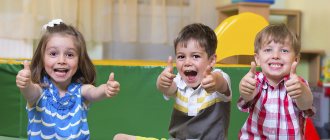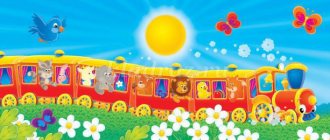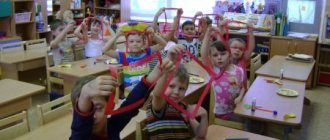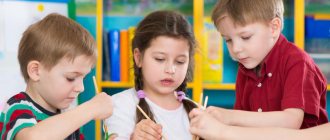LiveInternetLiveInternet
September.
No. 1. Topic: Introducing the concepts of “one” and “many”. Etc. tasks. To form ideas about the concepts of “many” and “one”. Work on the ability to coordinate the numeral “one” with nouns in gender and case. Develop the ability to compare objects by color, identify patterns in color changes. (Peterson “Player”, p. 16)
No. 2. Topic: Comparison of collections of objects by quantity. As many. Etc. tasks. Form ideas about the equality of groups of objects based on pairing (by overlapping, drawing lines, etc.). To consolidate ideas about the concepts of “one” and “many”. To train children in the ability to identify patterns in the arrangement of objects. (Peterson “Player”, p. 17)
.
No. 3. Topic: Same amount, more, less. Etc. tasks. Compare groups of objects by quantity using pairs (same, more, less). Form ideas about the conservation of quantity. (Peterson “Playing Game”, p. 19)
No. 4. Topic: Same amount, more, less. Etc. tasks. Reinforce the concepts of “one” - “many”, the ability to compare groups of objects by quantity based on pairing. Form ideas about the conservation of quantity. Development of logical thinking. (Peterson “Player”, p. 20)
OCTOBER
No. 1. Topic: Same amount, more, less. Etc. tasks. To consolidate ideas about the conservation of quantity, about comparing groups of objects based on pairing, about the concepts of “one” and “many”. Learn to see the components of a group of objects, each of which has a specific color. Help children find patterns. (Peterson “Player”, p. 22)
No. 2. Topic: Properties of objects. Count to two. Etc. tasks. Develop the ability to count to two based on comparison of two groups of objects containing 1 and 2 elements. Establish two ways to equalize groups of items by quantity. Learn to identify common properties of groups of objects. (Peterson “Playing Game”, p. 23)
No. 3. Topic: Counting to two. Numbers 1 and 2. Ex. tasks. Introduce the numbers 1 and 2 as symbols denoting one and two objects, respectively. Develop the ability to correlate numbers 1 and 2 with quantity; spatial representations: closer, further. (Peterson “Playing Game”, p. 24)
No. 4. Theme: longer, shorter. Etc. tasks. Form spatial representations: longer, shorter. Strengthen counting to two, the ability to correlate numbers 1 and 2 with quantity. Start working on the formation of spatial representations: right, left. (Peterson “Playing Game”, p. 28)
NOVEMBER
No. 1. Topic: Circle. Etc. tasks. Form an idea of a circle on an objective basis, the ability to recognize a circle in objects in the environment. Strengthen counting to two, the ability to correlate numbers 1 and 2 with quantity. Develop the ability to identify a pattern in the arrangement of figures and continue it. (Peterson “Player”, p. 29)
No. 2. Topic: Ball. Etc. tasks. To form, on an objective basis, ideas about the ball, the ability to recognize the ball in objects in the environment. Strengthen counting to two, the ability to correlate numbers 1 and 2 with quantity. Work on the formation of spatial representations: right, left. (Peterson “Playing Game”, p. 31).
No. 3. Topic: Wider, narrower. Etc. tasks. Form spatial concepts: wider, narrower. Strengthen counting to two, the ability to correlate numbers with quantities. Develop the ability to find signs of similarity and difference between objects, identify a pattern in the arrangement of figures and continue it. (Peterson “Player”, p. 32)
No. 4. Topic: Counting to three. Number 3. Ex. tasks. Introduce the formation of the number 3 based on a comparison of two groups of objects containing 2 and 3 elements; count to three. To consolidate the ability to compare groups of objects based on pairing, to equalize their quantities in two ways. Form ideas about the triangle on a subject basis; the ability to identify signs of similarities and differences between figures, and to find an extra figure. (Peterson “Player”, p. 35)
DECEMBER
No. 1. Topic: Number 3. Ex. tasks. Introduce the number 3 as a symbol denoting three objects. Develop the ability to correlate numbers 1-3 with quantity. Expand your understanding of geometric shapes. Develop the ability to identify a pattern in the arrangement of figures and continue it. (Peterson “playing game”, p. 37).
No. 2. Topic: On, over, under. Etc. tasks. Form spatial relationships: on, above, under. Strengthen counting to 3, the ability to correlate numbers 1-3 with quantity, compare by quantity based on pairing, equalize groups of objects by quantity in two ways. Develop the ability to count the required number of objects from a group. Strengthen the ability to compare objects by length. (Peterson “Playing Game”, p. 39).
No. 3. Topic: Above, below. Etc. tasks. Form spatial representations: above, below. Fix the score within 3, the ability to correlate numbers 1-3 with the quantity. Strengthen spatial concepts: closer, further. Develop the ability to group objects according to common characteristics. (Peterson “Player”, p. 41)
No. 4. Topic: Earlier, later. Etc. tasks. Form temporary ideas: earlier, later. Strengthen the ability to count objects, designate the quantity with the corresponding number. Develop the ability to identify signs of similarities and differences between objects or figures. (Peterson “Playing Game”, p. 43)
JANUARY
No. 1. Topic: Counting to 4. Number 4. Number 4. Ex. tasks. Introduce the formation of the number 4 based on a comparison of 2 groups of objects; count to 4. Introduce the number 4 as a symbol denoting 4 objects, learn to correlate numbers 1-4 with quantity. Strengthen the ability to compare groups of objects by quantity based on pairing, equalize the number of objects in two ways. To develop the ability to identify objects from a group based on their characteristic properties. (Peterson “Playing Game”, p. 44)
No. 2. Topic: Square. Etc. tasks. Introduce the square on a subject basis, consolidate knowledge about geometric shapes. Maintain counting within 4, ability to correlate numbers with quantity; to develop the ability to find signs of similarity and difference and, on their basis, combine objects with similar characteristics and isolate from a group objects that differ in some way. (Peterson “Player”, p. 47)
No. 3. Topic: Cube. Etc. tasks. Form an idea of a cube on an objective basis, the ability to recognize a cube in objects in the environment. Form spatial representations: left, right, middle. Fix the count within 4, the ability to correlate numbers with quantities. Strengthen temporary ideas: later, earlier. (Peterson “Player”, p. 49)
No. 4. Subject: Above. At the bottom. Etc. tasks. Create space representations: above, below; the ability to find signs of similarities and differences between objects and combine them into groups based on these signs. Reinforce ideas about geometric shapes on a subject basis, count within 4, compare groups based on making pairs. (Peterson “Player”, p. 51)
FEBRUARY
No. 1. Subject: Left, right, middle. Etc. tasks. Form spatial representations: left, right, middle. Fix counting within 4, the ability to correlate numbers 1-4 with quantity, spatial and temporal relationships; the ability to find signs of similarities and differences and express them in speech. (Peterson “Player”, p. 52)
No. 2. Topic: Counting to 5. Number 5. Number 5. Ex. tasks. Introduce the formation of the number 5 based on a comparison of two sets containing 4 and 5 elements; count to 5. Introduce the number 5 as a symbol representing 5 objects. Strengthen the ability to compare groups of objects based on pairing, equalize their quantities in two ways. (Peterson “Player”, p. 54)
No. 3. Topic: Inside, outside. Etc. tasks. Form spatial representations: inside, outside. Fix the score within 5, the ability to correlate numbers 1-5 with the quantity. Develop the ability to organize shapes by size. (Peterson “Playing Game”, p. 57)
No. 4. Topic: In front, behind, between. Etc. tasks. Form spatial representations: in front, behind, between. Strengthen counting within 5, the ability to correlate numbers 1-5 with quantity, ideas about geometric shapes and space-time relationships. Develop the ability to identify the properties of shapes (color, size, shape) and compare shapes based on these properties. (Peterson “Player”, p. 58)
MARCH
No. 1. Topic: Couple. Etc. tasks. Form ideas about paired objects. Strengthen the ability to compare objects by length, width, height. Fix the score within 5, the ability to correlate numbers with quantities. To develop the ability to identify, based on comparison, signs of similarity and difference between objects, and to express them in speech. (Peterson “Player”, p.60)
No. 2. Topic: Oval. Etc. tasks. To form an idea of an oval on an objective basis, the ability to find oval-shaped objects in the environment. Fix the score within 5, the ability to correlate numbers with quantities. Strengthen ideas about triangle, square, circle. (Peterson “Playing Game”, p. 62)
No. 3. Topic: Rectangle. Etc. tasks. Form an object-based idea of a rectangle, the ability to find rectangular-shaped objects in the environment. Fix the score within 5, the ability to correlate numbers with quantities. To develop the ability to identify the properties of objects, to find signs of similarity and difference, and on their basis to select from the totality objects that differ in some way. Strengthen the skills of comparing objects by length and width, ideas about geometric shapes. (Peterson “Player”, p. 64)
APRIL
No. 1. Topic: Number series. Etc. tasks. Based on objective actions, form ideas about order and number series. To develop the ability to navigate in space “from oneself”, to identify and continue a given pattern. Strengthen the ability to correlate numbers 1-5 with quantity. (Peterson “Player”, p. 67)
No. 2. Topic: Ordinal counting. Etc. tasks. Form ideas about ordinal counting. Strengthen ideas about preserving quantity, the ability to correlate numbers 1-5 with quantity. To develop the ability to compare figures, identify signs of similarity and difference, and express them in speech. (Peterson “Playing Game”, p. 69)
No. 3. Topic: Travel game. Etc. tasks. Strengthen children's understanding of numbers and numbers 1-5, the ability to recognize geometric shapes, space-time relationships. (Peterson “Player”, p. 70)
source
Mood now - mathematics, preschooler
Series of messages “Children 2-3 years old.
Lesson notes": Part 1 - Comprehensive lesson on speech development and modeling in the first junior group on the topic: "Kolobok" Part 2 - Long-term planning of art classes in the junior group Part 3 - Summary of a drawing lesson in the 1st junior group "Beautiful flowers for bees" Part 4 - Summary of a drawing lesson in the 1st junior group "Snail" Part 5 - Long-term planning in mathematics in the 2nd junior group. gr. Part 6 - Planning according to the Rainbow program for children of the 2nd junior group Part 7 - Modeling classes in the first junior group ... Part 12 - Exercises, educational games for a child of the third year of life Part 13 - How your child develops. Home tests Part 14 - Sleepy positions. Night indicator





